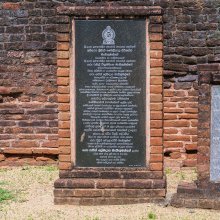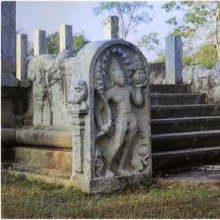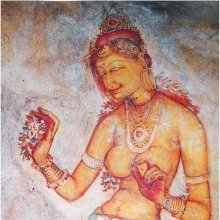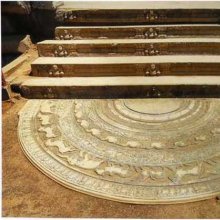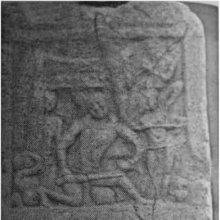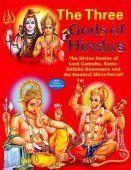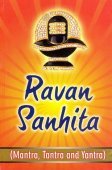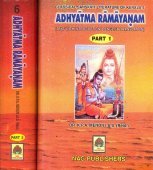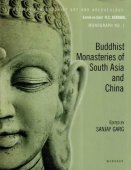Lanka, Laṅkā, Laṅka, Lamka, Lànkà: 31 definitions
Introduction:
Lanka means something in Buddhism, Pali, Hinduism, Sanskrit, Jainism, Prakrit, the history of ancient India, Marathi, Hindi, biology. If you want to know the exact meaning, history, etymology or English translation of this term then check out the descriptions on this page. Add your comment or reference to a book if you want to contribute to this summary article.
Images (photo gallery)
(+69 more images available)
In Hinduism
Vaishnavism (Vaishava dharma)
Source: ISKCON Press: GlossaryLaṅkā (लङ्का).—The golden city of Rāvaṇa, situated some eight hundred miles south of India, in Ceylon.

Vaishnava (वैष्णव, vaiṣṇava) or vaishnavism (vaiṣṇavism) represents a tradition of Hinduism worshipping Vishnu as the supreme Lord. Similar to the Shaktism and Shaivism traditions, Vaishnavism also developed as an individual movement, famous for its exposition of the dashavatara (‘ten avatars of Vishnu’).
Purana and Itihasa (epic history)
Source: archive.org: Puranic EncyclopediaLaṅkā (लङ्का).—The kingdom of Rāvaṇa. Origin. It is believed that the present island of Ceylon was the Laṅkā of the Purāṇas, the city of Rāvaṇa. This city of Laṅkā was situated on the top of the mountain Trikūṭa. This Trikūṭa was a peak of Mahāmeru. Because of a fight between Vāsuki and Vāyubhagavān this peak broke away from Mahāmeru and fell into the ocean. (See Para 5 under Kubera). (See full article at Story of Laṅkā from the Puranic encyclopaedia by Vettam Mani)
Source: archive.org: Shiva Purana - English TranslationLaṅkā (लङ्का) is the name of a ancient country/region from where the Rudrākṣa trees are said to be very sacred, according to the Śivapurāṇa 1.25, while explaining the greatness of Rudrākṣa:—“[...] Rudrākṣas grown in Gauḍa land became great favourites of Śiva. They were grown in Mathurā, Laṅkā, Ayodhyā, Malaya, Sahya mountain, Kāśī and other places. They are competent to break asunder the clustered sins unbearable to the others, as the sacred texts have declared”.
Source: Cologne Digital Sanskrit Dictionaries: The Purana IndexLaṅkā (लङ्का).—An upadvīpa to Jambūdvīpa; a great city in Trikūṭa; was besieged by Rāma and his Vānara hosts and made desolate by Rāvaṇa's indiscretion; Vibhīṣaṇa as king of; Jāmbavatī alluded to this incident in praising Kṛṣṇa;1 capital of Rāvaṇa;2 conquered by Arjuna; one of the places for residence of Agastya.3
- 1) Bhāgavata-purāṇa V. 19. 30; IX. 10. 16-33; X. 56. 28; Vāyu-purāṇa 48. 28.
- 2) Brahmāṇḍa-purāṇa III. 7. 266; 69. 35; Matsya-purāṇa 43. 37.
- 3) Ib. 61. 51.

The Purana (पुराण, purāṇas) refers to Sanskrit literature preserving ancient India’s vast cultural history, including historical legends, religious ceremonies, various arts and sciences. The eighteen mahapuranas total over 400,000 shlokas (metrical couplets) and date to at least several centuries BCE.
Kavya (poetry)
Source: Wisdom Library: KathāsaritsāgaraLaṅkā (लङ्का) is the name of a kingdom most difficult to reach, according to the Kathāsaritsāgara, chapter 12. Accordingly, when Vibhīṣaṇa (a king of Laṅkā) was visited by a Brāhman named Lohajaṅgha, he inquired how he managed to reach Laṅkā, whereupon Lohajaṅgha answered:
“I am a Brāhman of the name of Lohajaṅgha residing in Mathurā; and I, Lohajaṅgha, being afflicted at my poverty, went to the temple of the god, and remaining fasting, for a long time performed austerities in the presence of Nārāyaṇa. Then the adorable Hari commanded me in a dream, saying: ‘Go thou to Vibhīṣaṇa, for he is a faithful worshipper of mine, and he will give thee wealth.’ Then I said: ‘Vibhīṣaṇa is where I cannot reach him.’ But the lord continued: ‘To-day shalt thou see that Vibhīṣaṇa.’ So the lord spake to me, and immediately I woke up and found myself upon this side of the sea. I know no more.”
The Kathāsaritsāgara (‘ocean of streams of story’), mentioning Laṅkā, is a famous Sanskrit epic story revolving around prince Naravāhanadatta and his quest to become the emperor of the vidyādharas (celestial beings). The work is said to have been an adaptation of Guṇāḍhya’s Bṛhatkathā consisting of 100,000 verses, which in turn is part of a larger work containing 700,000 verses.
Source: archive.org: Aspects of Bengal society: Ship-building and commerceLanka is the name of an ancient city mentioned by the author of the Kavikankan’s Chandikāvya pp. 195-202.—Accordingly, after the performance of the usual ceremonies before sailing, the merchant Dhanapati passed the following places: [...]—all by the side of the Ganges. Then he reached the very celebrated inland port of Bengal known as Saptagram near the Tribeni. The poet here incidentally praised this port and gave it a superiour place among the following ports and places: [e.g., Lanka, etc...]. According to the poet the merchants of the above places visit Saptagram but the merchants of Saptagram do never visit those ports and places.
Source: Shodhganga: A critical appreciation of soddhalas udayasundarikathaLaṅkā (लङ्का).—One of the various countries and cities mentioned by Soḍḍhala.—Laṅkā seems to he situated in the Southern-most part of the Indian Peninsula, as an island in the Indian ocean. It is identified with Ceylon. Soḍḍhala has referred to it as Laṅkā-puri decked with gold. He says, “It is an abode of demons containing golden buildings and the fortresses. Formerly it was overcome by the tender-hearted Rāma. Vibhīṣaṇa, the successor of Rāvaṇa had a treasury of gold amassed since the time of Kubera.”
Rāmāyaṇa describes the luxury of the people in Laṅkā. The lovely city had well-arranged high roads, and outstretched rows of the palatial buildings with its golden windows and pillars. The mansions of the demons were shining with places paved with sphatika, adorned with gold, variegated with vaidūrya and studed with the rows of pearls.
Source: Shodhganga: The Kavyamimamsa of RajasekharaLaṅkā (लङ्का) is the name a locality mentioned in Rājaśekhara’s 10th-century Kāvyamīmāṃsā.—Laṅkā seems to be identified in the most-southern parts of the Indian peninsula, as an island somewhere in the Indian Ocean. In the Rāmāyaṇa, Rājaśekhara’s Kāvyamīmāṃsā and Bālarāmāyaṇa, the description of this island does not favour its identification with Ceylon or Siṃhala. This island is situated on the western side of the peninsula beyond Travancore, while Siṃhala or Ceylon is on the eastern side of it.

Kavya (काव्य, kavya) refers to Sanskrit poetry, a popular ancient Indian tradition of literature. There have been many Sanskrit poets over the ages, hailing from ancient India and beyond. This topic includes mahakavya, or ‘epic poetry’ and natya, or ‘dramatic poetry’.
Jyotisha (astronomy and astrology)
Source: Wisdom Library: Brihat Samhita by VarahamihiraLaṅkā (लङ्का) refers to a country identified with Ceylon, belonging to “Dakṣiṇa or Dakṣiṇadeśa (southern division)” classified under the constellations of Uttaraphālguni, Hasta and Citrā, according to the system of Kūrmavibhāga, according to the Bṛhatsaṃhitā (chapter 14), an encyclopedic Sanskrit work written by Varāhamihira mainly focusing on the science of ancient Indian astronomy astronomy (Jyotiṣa).—Accordingly, “The countries of the Earth beginning from the centre of Bhāratavarṣa and going round the east, south-east, south, etc., are divided into 9 divisions corresponding to the 27 lunar asterisms at the rate of 3 for each division and beginning from Kṛttikā. The constellations of Uttaraphālguni, Hasta and Citrā represent the southern division consisting of [i.e., Laṅkā] [...]”.
Source: Wikibooks (hi): Sanskrit Technical TermsLaṅkā (लङ्का).—The hypothetical place on the equator where the meridian of Ujjain intersects it, i.e., place with 0° longitude and 0° latitude. Note: Laṅkā is a Sanskrit technical term used in ancient Indian sciences such as Astronomy, Mathematics and Geometry.
Source: academia.edu: Tessitori Collection I (astronomy)Laṅkā (लङ्का) refers to the “terrestrial equator”, according to the Karaṇakutūhala by Bhāskara (classified as literature dealing with astronomy, astrology, divination, medicine) of which a commentary is included in the collection of manuscripts at the ‘Vincenzo Joppi’ library, collected by Luigi Pio Tessitori during his visit to Rajasthan between 1914 and 1919.—According to prof. S.R. Sarma: “The manuscript of the Karaṇakutūhala starts with the enumeration of the laṅkodayas (right ascensions or the rising times of the zodiac signs at laṅkā, the terrestrial equator) and teaches how to compute from the svodayas (oblique ascensions or rising times at one’s own latitude). A table at the top on 1v displays the two sets of parameters. These parameters are given in palas (= 1/60th part of ghaṭī). The oblique ascensions in the bottom row of the table on 1v are obtained by subtracting or adding the ascensional differences (carakhaṇḍas) in the middle row from/to the right ascensions in the upper row” (S.R. Sarma).

Jyotisha (ज्योतिष, jyotiṣa or jyotish) refers to ‘astronomy’ or “Vedic astrology” and represents the fifth of the six Vedangas (additional sciences to be studied along with the Vedas). Jyotisha concerns itself with the study and prediction of the movements of celestial bodies, in order to calculate the auspicious time for rituals and ceremonies.
General definition (in Hinduism)
Source: WikiPedia: HinduismLaṅkā (लंका): An island city, generally identified with Ceylon, the home of Ravana.
In Buddhism
Theravada (major branch of Buddhism)
Source: Pali Kanon: Pali Proper NamesPali names for Ceylon, found in the Chronicles - e.g., Dipavamsa, Mahavamsa and the Commentaries.
An ancient tradition recorded in the Mahavamsa (Mhv.xv. 57ff), and in the Samantapasadika (Sp.i.86ff), gives the names of the Island in the times of the three previous Buddhas, the names of the capital cities, the different names of Mahameghavana, and of the kings contemporary with these Buddhas.
Thus, in the time of Kakusandha, the Island was called Ojadipa, the king was Abhaya, the capital Abhayapura and Mahameghavana, Mahatittha. In the time of Konagamana, the Island was Varadipa, the capital Vaddhamana, the king Samiddha and the park Mahanoma. In the time of Kassapa, the Island was Mandadipa, the king Jayanta, the capital Visala and the park Mahasagara.Besides Mahameghavana, the other physical feature of Ceylon, mentioned in these accounts, is the mountain known in the present age as Sumanakuta, whereon the Buddha Gotama placed his footprint. During the ages of the three previous Buddhas, it was known, respectively, as Devakuta, Sumanakutaka and Subhakuta. Gotama paid three visits to Ceylon, while the other three Buddhas came only once. During their visits they consecrated various spots by spending there a short time wrapt in meditation.
Lanka was once inhabited by Yakkhas. Gotama Buddha obliged them to leave the Island and seek shelter in the neighboring Giridipa. Lankadipa was later colonized by Vijaya and his three hundred companions. Two cities of the Yakkhas are mentioned: Sirisavatthu and Lankapura.
Theravāda is a major branch of Buddhism having the the Pali canon (tipitaka) as their canonical literature, which includes the vinaya-pitaka (monastic rules), the sutta-pitaka (Buddhist sermons) and the abhidhamma-pitaka (philosophy and psychology).
In Jainism
General definition (in Jainism)
Source: archive.org: TrisastisalakapurusacaritraLaṅkā (लङ्का) is the name of a city on top of the Trikūṭa mountain in Rākṣasadvīpa, according to chapter 2.4 [ajitanātha-caritra] of Hemacandra’s 11th century Triṣaṣṭiśalākāpuruṣacaritra: an ancient Sanskrit epic poem narrating the history and legends of sixty-three illustrious persons in Jainism.
Accordingly, as Bhīma (i.e., the Lord of the Rākṣasas) said to Meghavāhana (i.e., Ghanavāhana): “[...] In the ocean Lavaṇoda is the crest-jewel of all islands, Rākṣasadvīpa, unconquerable even by the gods, extended for seven hundred yojanas in all directions. At its center is Mount Trikūṭa, like Sumeru at the center of the earth, very splendid, circular, nine yojanas high, fifty yojanas in diameter, very difficult of access. On its top I have made just now a city, named Laṅkā, provided with golden walls, houses, and arched gateways. [...]”.

Jainism is an Indian religion of Dharma whose doctrine revolves around harmlessness (ahimsa) towards every living being. The two major branches (Digambara and Svetambara) of Jainism stimulate self-control (or, shramana, ‘self-reliance’) and spiritual development through a path of peace for the soul to progess to the ultimate goal.
India history and geography
Source: academia.edu: The Chronological History of Ancient Sri LankaBefore ~7000 BCE, ancient Sri Lanka was not an island but it was well-connected through land route with Indian peninsula. Tamraparni River that originated in Tamilnadu used to flow from Tirunelveli district to Puttalam of western Sri Lanka.
Mayil Vakanar starts Sri Lankan history from the Ramayana era. According to him, Rakshasas reigned over Sri Lanka for three Yugas. Rama killed Ravana and gave the kingdom to Vibhishana. He says that King Vijaya came to Sri Lanka and built many Koyils (Temples). In the year Saka 358 (225 BCE), Kulakkoddu Maharaja, the son of Manu Nidhi Cholan of Kaveri Pum Pattanam took over the control over Anuradhapura. This perfectly reconciles with the Chulavamsa which also confirms that the Cholas occupied Anuradhapura in the 36 th regnal year of Mahinda V i.e. 212 BCE. Mayil Vakanar mentions that King Aggrabodhi? (Siri Sanghabodhi Parakramabahu I) was ruling in Saka 515 (68 BCE).
Source: Project Gutenberg: Castes and Tribes of Southern India, Volume 11) Lanka (“island”) is one of the many exogamous septs (division) among the Boyas (an old fighting caste of Southern India). The Boyas were much prized as fighting men in the stirring times of the eighteenth century .
2) Lanka (“island”) is one of the exogamous septs (divisions) among the Kammas (agriculturists and traders). The word Kamma in Telugu means the ear-ornament, such as is worn by women. The Razus, who now claim to be Kshatriyas, were probably descended from Kapus, Kammas, and Velamas.
Source: Cologne Digital Sanskrit Dictionaries: Indian Epigraphical GlossaryLaṅka.—(EI 19), a carpenter; cf. Leṅka, Leṅkā, Bud8hāleṅkā. Note: laṅka is defined in the “Indian epigraphical glossary” as it can be found on ancient inscriptions commonly written in Sanskrit, Prakrit or Dravidian languages.

The history of India traces the identification of countries, villages, towns and other regions of India, as well as mythology, zoology, royal dynasties, rulers, tribes, local festivities and traditions and regional languages. Ancient India enjoyed religious freedom and encourages the path of Dharma, a concept common to Buddhism, Hinduism, and Jainism.
Biology (plants and animals)
Source: Wisdom Library: Local Names of Plants and DrugsLamka in the Telugu language is the name of a plant identified with Lathyrus sativus L. from the Fabaceae (pea) family. For the possible medicinal usage of lamka, you can check this page for potential sources and references, although be aware that any some or none of the side-effects may not be mentioned here, wether they be harmful or beneficial to health.
Lanka in the Bengali language is the name of a plant identified with Cucurbita pepo L. from the Cucurbitaceae (Pumpkin) family having the following synonyms: Cucumis pepo.
Source: Google Books: CRC World Dictionary (Regional names)1) Lanka in Gabon is the name of a plant defined with Laccosperma secundiflorum in various botanical sources. This page contains potential references in Ayurveda, modern medicine, and other folk traditions or local practices It has the synonym Calamus secundiflorus P. Beauv. (among others).
2) Lanka in India is also identified with Lathyrus sativus It has the synonym Lathyrus asiaticus (Zalkind) Kudr. (etc.).
Example references for further research on medicinal uses or toxicity (see latin names for full list):
· Bangladesh Journal of Botany (1994)
· Botanical Journal of the Linnean Society (1997)
· Proceedings of the Indian Science Congress Association (1990)
· Journal of Cytology and Genetics (1997)
· Cytologia (1992)
· African Study Monographs (2004)
If you are looking for specific details regarding Lanka, for example chemical composition, extract dosage, side effects, health benefits, pregnancy safety, diet and recipes, have a look at these references.

This sections includes definitions from the five kingdoms of living things: Animals, Plants, Fungi, Protists and Monera. It will include both the official binomial nomenclature (scientific names usually in Latin) as well as regional spellings and variants.
Languages of India and abroad
Marathi-English dictionary
Source: DDSA: The Molesworth Marathi and English Dictionarylaṅkā (लंका).—f (S) The capital of rāvaṇa in Ceylon. The name is extended also to the island which, according to the Hindus, is larger and more distant from the continent than in reality. It is thus placed in the Eastern ocean south of Ceylon, and is, according to Wilford, the peninsula of Malacca. 2 Figures of giants, monkeys, trees &c. made of gunpowder (as fireworks). laṅkā luṭaṇēṃ (To plunder Lanka.) To obtain vast treasures.
--- OR ---
lāṅka (लांक).—m f ē (laṅka S) A grain, Lithyrus sativus.
--- OR ---
lāṅka (लांक) [or लांकण, lāṅkaṇa].—f C Junction or connection by means of a rope &c. (of beasts or of men). v ghāla. 2 fig. Unitedness through some subject or ground of common concernment or reciprocal relation. Ex. bandyā adhēlyā nasalyā tara dōghāṃ dōghāṃsa ēka ēka rupayā dēūna dōghāṃ dōghāñcī lāṅka ghālūna dyāvī.
Source: DDSA: The Aryabhusan school dictionary, Marathi-Englishlaṅkā (लंका).—f The capital of rāvaṇa in Ceylon.
--- OR ---
lāṅka (लांक) [or lāṅkaṇa, or लांकण].—f Junction or connection by means of a rope.
Marathi is an Indo-European language having over 70 million native speakers people in (predominantly) Maharashtra India. Marathi, like many other Indo-Aryan languages, evolved from early forms of Prakrit, which itself is a subset of Sanskrit, one of the most ancient languages of the world.
Sanskrit dictionary
Source: DDSA: The practical Sanskrit-English dictionaryLaṅkā (लङ्का).—[lak-ac mum ca]
1) Name of the capital and residence of Rāvaṇa and identified with the island of Ceylon or the chief town in it; according to some Laṅkā was much larger than the present island of Ceylon. It was originally built for Mālyavat q. v.; विजेतव्या लङ्का चरणतरणीयो जलनिधिः (vijetavyā laṅkā caraṇataraṇīyo jalanidhiḥ) Udb.
2) An unchaste woman, a prostitute, harlot.
3) A branch.
4) A kind of grain. (Mar. lāṃka).
--- OR ---
Laṅka (लङ्क).—A lover, paramour.
Derivable forms: laṅkaḥ (लङ्कः).
Source: Cologne Digital Sanskrit Dictionaries: Shabda-Sagara Sanskrit-English DictionaryLaṅkā (लङ्का).—f.
(-ṅkā) 1. The capital of Ravana in Ceylon; the name is extended also to the island, which according to the notions of the Hindus, is much more considerable in size, and lies further from the continent than in reality; it is described as being equal to one-twelvth of the equatorial circumference of the earth, and is one of the places lying under the first meridian, whence the longitude is computed; it is thus placed in the Eastern ocean, South of Ceylon, and according to Wilford is the peninsula of Malacca: according to some Hindu accounts also, it is distinct from Ceylon, from which island Lanka is said to be just visible. 2. A goddess or evil spirit, one of the Sakinis, perhaps the same as the tutelary deity of the city of Lanka. 3. An unchaste woman. 4. A branch. 5. A kind of grain. E. lak to obtain, (happiness, in which,) aff. ac, and num irr. augment.
Source: Cologne Digital Sanskrit Dictionaries: Benfey Sanskrit-English DictionaryLaṅkā (लङ्का).—f. 1. The capital of Ceylon, [Lassen, Anthologia Sanskritica.] 5, 3. 2. Ceylon, [Rāmāyaṇa] 3, 53, 35; [Pañcatantra] iii. [distich] 268. 3. The name of a Śākinī, or evil spirit. 4. An unchaste woman. 5. A branch.
Source: Cologne Digital Sanskrit Dictionaries: Cappeller Sanskrit-English DictionaryLaṅkā (लङ्का).—[feminine] [Name] of the chief town in Ceylon & the island itself.
Source: Cologne Digital Sanskrit Dictionaries: Monier-Williams Sanskrit-English Dictionary1) Laṅka (लङ्क):—m. Name of a man [gana] naḍādi
2) Laṅkā (लङ्का):—[from laṅka] a f. See below.
3) [from laṅka] b f. Name of the chief town in Ceylon or of the whole island (renowned as the capital of the great Rākṣasa Rāvaṇa q.v.; [according to] to some accounts L° was much larger than the island of Ceylon is at present, or was even distinct from it, the first meridian of longitude which passed through Ujjayinī being supposed to pass through L°), [Mahābhārata; Rāmāyaṇa] etc.
4) [v.s. ...] Name of a lake (= rāvaṇa-hrada), [Rāmāyaṇa]
5) [v.s. ...] of a Yoginī, [Hemādri’s Caturvarga-cintāmaṇi]
6) [v.s. ...] of a Śākinī or evil spirit, [cf. Lexicographers, esp. such as amarasiṃha, halāyudha, hemacandra, etc.]
7) [v.s. ...] an unchaste woman, [cf. Lexicographers, esp. such as amarasiṃha, halāyudha, hemacandra, etc.]
8) [v.s. ...] a branch, [cf. Lexicographers, esp. such as amarasiṃha, halāyudha, hemacandra, etc.]
9) [v.s. ...] a kind of grain, [cf. Lexicographers, esp. such as amarasiṃha, halāyudha, hemacandra, etc.]
Source: Cologne Digital Sanskrit Dictionaries: Yates Sanskrit-English DictionaryLaṅkā (लङ्का):—(ṅkā) 1. f. The capital of Rāvana in Ceylon; an evil spirit; an unchaste woman; a branch.
[Sanskrit to German]
Sanskrit, also spelled संस्कृतम् (saṃskṛtam), is an ancient language of India commonly seen as the grandmother of the Indo-European language family (even English!). Closely allied with Prakrit and Pali, Sanskrit is more exhaustive in both grammar and terms and has the most extensive collection of literature in the world, greatly surpassing its sister-languages Greek and Latin.
Hindi dictionary
Source: DDSA: A practical Hindi-English dictionaryLanka in Hindi refers in English to:—(nf) Ceylon—the island in the Indian ocean where Rawan, the demon king and villain of the ancient epic Ramayan, ruled; ~[natha/pati] the ruler of [lamka] —an epithet of Rawan; ~[kamda] arson, a burning episode; -[mem saba bavana gaja/hatha ke] where every hand fleeceth, the sheep go naked; all as black as the devil..—lanka (लंका) is alternatively transliterated as Laṃkā.
...
Kannada-English dictionary
Source: Alar: Kannada-English corpusLaṃka (ಲಂಕ):—[noun] a workman who builds and repairs wooden things, esp. the wooden parts of buildings, ships, etc.; a carpenter.
--- OR ---
Lāṃka (ಲಾಂಕ):—
1) [noun] the plant Lathyrus sativus of Papilionaceae family.
2) [noun] its pea.
Kannada is a Dravidian language (as opposed to the Indo-European language family) mainly spoken in the southwestern region of India.
See also (Relevant definitions)
Starts with (+51): Lamkaduti, Lanka amba, Lanka kaalo, Lanka kala, Lanka sij, Lanka Vihara, Lanka-jaba, Lanka-kalo, Lanka-sani, Lankaasaani, Lankada, Lankadahin, Lankadesha, Lankadhikari, Lankadhinayaka, Lankadhipa, Lankadhipati, Lankadhiraja, Lankadi, Lankadipa.
Ends with (+39): Addhapallanka, Ahulanka, Akalanka, Alankamalanka, Allamka, Amlamka, Amtahkalamka, Apakalanka, Apalanka, Ataikkalanka, Atamkakalamka, Bhalanka, Bhimakalanka, Cilanka, Culanka, Dhavalanka, Gellamka, Golanka, Harinakalanka, Jalanka.
Full-text (+1209): Ravana, Lankasthayin, Lankodaya, Lankesha, Lankayana, Lankapati, Vibhishana, Trikuta, Lankakayani, Lankadhipati, Lankas, Lankadahin, Adhilankam, Lank, Lankopika, Lamka, Lankadesha, Lankakanda, Lankanagari, Yamakoti.
Relevant text
Search found 165 books and stories containing Lanka, Laṅkā, Lāṅka, Laṅka, Lamka, Laṃkā, Laṃka, Lāṃka, Lānka, Lànkà; (plurals include: Lankas, Laṅkās, Lāṅkas, Laṅkas, Lamkas, Laṃkās, Laṃkas, Lāṃkas, Lānkas, Lànkàs). You can also click to the full overview containing English textual excerpts. Below are direct links for the most relevant articles:
Garga Samhita (English) (by Danavir Goswami)
Verse 5.11.5 < [Chapter 11 - The Stories of Kubjā and Kuvalayāpīḍa]
Verse 1.4.59 < [Chapter 4 - Description of Questions About the Lord’s Appearance]
Verse 8.13.33 < [Chapter 13 - A Thousand Names of Lord Balarāma]
Hanuman Nataka (critical study) (by Nurima Yeasmin)
Hanuman-Nāṭaka, Act 6 (Summary) < [Chapter 3]
8.1. Geographical Information in the Hanumannāṭaka < [Chapter 5]
Hanuman-Nāṭaka, Act 9 (Summary) < [Chapter 3]
Tiruvaymoli (Thiruvaimozhi): English translation (by S. Satyamurthi Ayyangar)
Pasuram 7.4.7 < [Section 4 - Fourth Tiruvaymoli (Ali ela)]
Pasuram 7.6.8 < [Section 6 - Sixth Tiruvaymoli (Pa maru muvulakum)]
Pasuram 2.4.3 < [Section 4 - Fourth Tiruvaymoli (Ati ati)]
Trishashti Shalaka Purusha Caritra (by Helen M. Johnson)
Part 2: Story of Meghavāhana < [Chapter V - Life and death of the sons of Sagara]
Part 1: Expedition to Laṅkā < [Chapter VII - The killing of Rāvaṇa]
Part 4: Rāvaṇa’s sons < [Chapter II - Rāvaṇa’s expedition of Conquest]
The Gautami Mahatmya (by G. P. Bhatt)
The backdrop of the Srikanthacarita and the Mankhakosa (by Dhrubajit Sarma)
Part 8a - Countries and cities (found in the Śrīkaṇṭhacarita) < [Chapter IV - Socio-cultural study of the Śrīkaṇṭhacarita]
Part 2 - The Maṅkhakośa: authorship and date < [Chapter V - The Maṅkhakośa]
Part 8c - Mountains (found in the Śrīkaṇṭhacarita) < [Chapter IV - Socio-cultural study of the Śrīkaṇṭhacarita]
Related products
(+4 more products available)
